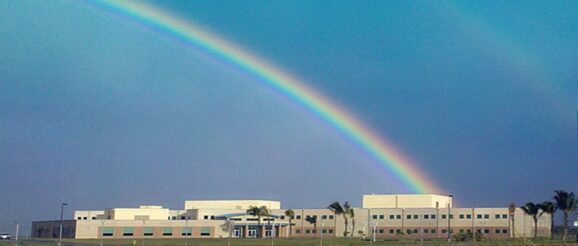Innovation Guides NSA-Hawaii

 A double rainbow looms over the NSA/CSS Center in Oahu, Hawaii. The building is named after Capt. Joseph T. Rochefort, USN, whose team provided the key intelligence that helped win the 1942 Battle of Midway. The agency is looking to industry and academia for innovations vital to its changing mission. Credit: NSA/CSS
A double rainbow looms over the NSA/CSS Center in Oahu, Hawaii. The building is named after Capt. Joseph T. Rochefort, USN, whose team provided the key intelligence that helped win the 1942 Battle of Midway. The agency is looking to industry and academia for innovations vital to its changing mission. Credit: NSA/CSS
The National Security Agency/Central Security Service (NSA/CSS)-Hawaii is looking toward innovation, both in technology and in service, as it ramps up to meet the challenges posed in the region covered by the Indo-Pacific Command (INDOPACOM). And these challenges have evolved during the COVID-19 pandemic, notes the head of the office.
Capt. Kurtis Mole, USN, commander, NSA/CSS Hawaii, addressed the opportunities NSA/CSS is seizing during his keynote address on the third day of TechNet Indo-Pacific, running virtually March 1-3. Capt. Mole defined the agency’s challenges against the backdrop of the vast Indo-Pacific region while noting its applicability worldwide.
“Our natural strategies identify the two plus three—those adversaries who use all domains to undermine our national interest and pose a corrosive threat often operating below the threshold of armed conflict.,” he stated “This includes China, Russia, Iran, North Korea, as well as violent extremist organizations.
Our two core missions are SIGINT, where we exploit our adversaries’ communications and networks, as well as cybersecurity, where we protect our own networks, data and weapon systems.—Capt. Kurtis Mole, USN, commander, NSA/CSS Hawaii @NSAGov #AFCEATechNet
— Bob Ackerman (@rkackerman) March 3, 2021
“Our two core missions are SIGINT, where we exploit our adversaries’ communications and networks, as well as cybersecurity, where we protect our own networks, data and weapon systems,” Capt. Mole continued. He added that the pandemic has changed the landscape, but it hasn’t lessened the need for NSA to stay atop regional issues.
“The last 12 months in enduring the COVID-19 pandemic has only heightened the importance of our missions in the face of these ever-growing challenges,” he stated. “Our adversaries haven’t taken a break during COVID, and the threat landscape has only grown more complex.”
The culture of innovation has helped the NSA react to the reality of a global pandemic … . We saw the pandemic as an opportunity to re-think some old ways.—Capt. Kurtis Mole, USN, commander, NSA/CSS Hawaii @NSAGov #AFCEATechNet
— Bob Ackerman (@rkackerman) March 3, 2021
Capt. Mole emphasized the NSA’s expanding reach of cooperation. “We don’t operate alone. We rely on strong partnerships to be the core of what we do,” he said, adding, “I’m talking about partnerships with the U.S. Cyber Command, across the intelligence community and broader government, with foreign partners, with academia and with industry.”
We don’t operate alone. We rely on strong partnerships to be the core of what we do.—Capt. Kurtis Mole, USN, commander, NSA/CSS Hawaii @NSAGov #AFCEATechNet
— Bob Ackerman (@rkackerman) March 3, 2021
The partnership with industry is growing in importance as technology increasingly drives the NSA’s capabilities. And, industry also is rife with many of the skills that the NSA needs for its mission.
“The competition for cyber talent has grown fiercer every year,” he observed. “We want to change the conversation: It’s not about drawing lines between the talent that works directly for you and talent elsewhere; it’s about building connections and finding common purpose and intent.”
The captain described how his office has saturated Hawaii with programs in grades K-12, high school and college to raise interest and open up students to a career in cybersecurity. This effort includes STEM scholarships, he added. Even with the COVID pandemic, this year his office doubled the number of high school work study students it has in its workspaces. “I see every external engagement as an opportunity to recruit not only for the National Security Agency, but for the broader intelligence community and industry,” he declared.
Despite the COVID pandemic, this year we doubled the number of high school work study students we have in our workspaces.—Capt. Kurtis Mole, USN, commander, NSA/CSS Hawaii @NSAGov #AFCEATechNet
— Bob Ackerman (@rkackerman) March 3, 2021
The partnership with industry has led to greater emphasis on unclassified venues and activities. Even before COVID-19, the NSA was focused on engaging in unclassified environments in a significant way. This constituted putting down the technology and the capabilities to work with its partners where they are, and in many cases that’s unclassified, he noted. “So the pandemic offered just another indicator that we’re moving in the right direction, and we see a lot of room for improvement,” Capt. Mole allowed. “NSA has created new unclassified options for engaging our external partners both physically and virtually.”
